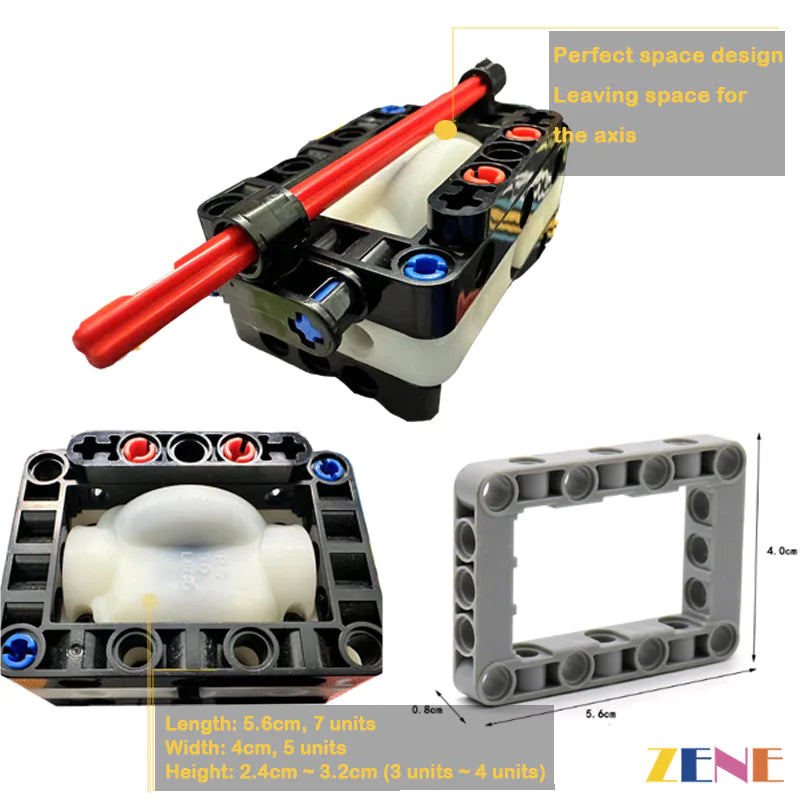Understanding Escapements: The Heart of Mechanical Timekeeping
In the intricate world of mechanical timekeeping, few components are as crucial yet as misunderstood as the escapement. This remarkable mechanism, often called the "heart" of any mechanical clock, serves as the critical interface between the power source and the timekeeping element, regulating the release of energy in precise, controlled intervals.
There are many Lego clocks around, but most of them are really huge contraptions, and for a good reason. They are easier to tune, more efficient, work longer....... At its core, every mechanical clock faces the same fundamental challenge: how to convert the continuous force from a power source—whether it's a wound spring, falling weight, or gravity—into the regular, precise intervals that we recognize as time. Without proper regulation, a weight would simply fall as quickly as possible, spinning the clock's hands in a useless blur.
This is where the escapement enters the picture, acting as a sophisticated regulatory valve that meters out energy in carefully controlled pulses. They work in harmony with a pendulum or balance wheel, creating a feedback loop where the timekeeping element (pendulum) controls the rate at which energy is released, while the escapement ensures that this release happens in discrete, measurable increments.
The Physics of Pendulum Regulation
A pendulum's period—the time it takes to complete one full swing—depends primarily on its length and the local gravitational field. For a simple pendulum, this relationship follows the well-known formula involving the square root of length divided by gravitational acceleration. However, in compact timepieces, achieving the desired one-second period becomes challenging.
One particularly elegant approach involves using a compound pendulum system where a second mass is positioned above the pivot point. This additional mass effectively slows down the pendulum's oscillation, allowing for a much shorter physical length while maintaining the desired period.
Exploring Different Escapement Mechanisms
The Arnfield Gravity Escapement
This was possible with very small and reasonably efficient Arnfield gravity escapement. Just a small update that to extend the operating time to 50 hours. This mechanism operates on a fascinating principle where the pendulum literally lifts a small weight (the gravity arm) from an upper position to a lower position during its swing. The potential energy difference between these positions is what powers the pendulum's continued motion.
Tips: The smooth, shock-free operation of the Arnfield escapement allows for very light pendulum construction and exceptional overall efficiency. However, tuning such a system requires careful attention to several critical parameters. The gravity arm must be light enough that the escape wheel can lift it reliably, yet heavy enough to provide sufficient unlocking force. If the arm is too light, it may fail to unlock the escape wheel entirely. If too heavy, it may cause erratic jumping or excessive power consumption.
The Grasshopper Escapement
The grasshopper escapement design, originally invented by John Harrison in the 18th century, uses a unique rocking motion that resembles the leg movement of a grasshopper—hence its name. The grasshopper escapement is particularly notable for its ability to operate with minimal power consumption, making it ideal for long-running timepieces.
Traditional Escapements & Modern Innovations
If you in any case will have an electrical timebase in some way, you could always build a stepper motor. However, forcing a pendulum to oscillate at a frequency different from its natural period requires significantly more energy than operating at resonance. This presents interesting engineering trade-offs between accuracy and power consumption that clockmakers must carefully consider.
Escapement Tuning
Tuning an escapement represents one of the most challenging aspects of clockmaking. The process requires balancing multiple competing factors: unlocking force, locking depth, impulse delivery, and power consumption. Each adjustment affects the others, creating a complex optimization problem that often requires extensive trial and error.
The sensitivity of these mechanisms to external disturbances cannot be overstated. Even minor vibrations—such as those caused by a sneeze—can alter the clock's rate. This sensitivity is both a curse and a blessing: while it makes the clocks challenging to operate in real-world conditions, it also demonstrates the remarkable precision inherent in these mechanical systems.
Power Sources and Efficiency Considerations
The power source for mechanical clocks significantly impacts their design and performance. Traditional weight-driven clocks use the gravitational potential energy of a falling mass to power the mechanism. A typical compact clock might operate on as little as 100 grams of driving weight, but this constrains the running time to perhaps one hour unless extraordinary efficiency measures are implemented.
The relationship between power consumption and accuracy creates interesting design challenges. Adding complexity like seconds hands increases power demands significantly, sometimes making them impractical for low-power systems. Similarly, longer drivetrains with higher gear ratios can extend running times but may introduce additional friction and backlash that affects accuracy.
The Future of Mechanical Timekeeping
Modern mechanical clockmaking, whether in traditional materials or innovative mediums like LEGO, continues to push boundaries. Concepts like tourbillons—rotating escapement mechanisms originally designed to average out positional errors—showcase the ongoing evolution of horological thinking.
As we continue to develop increasingly sophisticated electronic devices, the elegant simplicity and mechanical beauty of escapements remind us that some of the most profound engineering solutions arise from deeply understanding fundamental physical principles and expressing them through precise mechanical relationships. In every tick of a mechanical clock, we hear the echo of centuries of human ingenuity applied to one of our most fundamental needs: the measurement of time itself.























Leave a comment
Please note, comments need to be approved before they are published.